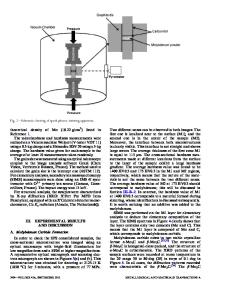Densification of thoria through flash sintering
- PDF / 645,427 Bytes
- 6 Pages / 612 x 792 pts (letter) Page_size
- 63 Downloads / 304 Views
Research Letter
Densification of thoria through flash sintering W. Straka, Department of Materials Science and Engineering, North Carolina State University, Raleigh, NC 27606, USA S. Amoah, Department of Materials Science and Engineering, North Carolina State University, Raleigh, NC 27606, USA; Department of Physics, Lenoir Rhyne University, Hickory, NC 28601, USA J. Schwartz, Department of Materials Science and Engineering, North Carolina State University, Raleigh, NC 27606, USA Address all correspondence to W. Straka at [email protected] (Received 8 May 2017; accepted 2 August 2017)
Abstract Thorium dioxide (thoria, ThO2) is used in refractory applications and as nuclear fuel. Its melting temperature, the highest of any binary oxide, makes it a difficult system to process. Here we report on the effects of flash sintering on the densification of thoria. We found 95% of theoretical density is obtained at ∼950 °C (∼30% of the melting temperature) with an electric field of 800 V/cm. Variation in power density had a minimal effect on the densification. Scanning electron microscopy images show the effects of flash sintering on grain size as a function of electric field.
Introduction Thorium dioxide (thoria, ThO2) is a binary oxide ceramic with the highest melting temperature of any known binary oxide.[1,2] As a result, thoria is an important refractory material for many applications. Furthermore, thoria is an important nuclear fuel in several countries because it is more abundant than uranium, is nuclear proliferation-resistant, and can produce more energy per unit mass than uranium-based fuels.[3] Although its high melting temperature is one of thoria’s attractive features, it also makes it difficult to obtain the fully-dense materials required for refractory and nuclear applications, and in general processing thoria is challenging. To overcome the processing barrier, many techniques have been investigated to find their efficacy for thoria sintering. Examples of this include variation in the sintering atmosphere[4,5] and reduction in particle size.[6,7] At best, these studies yielded dense thoria at temperatures exceeding 1600 °C.[5] Another thoria densification method involves the addition of sintering aids such as alumina,[5] niobia,[8,9] calcia,[6] vanadia, and tantala.[10] Of these, niobia, vanadia, and tantala yielded the most promising results with theoretical densities exceeding 95% with sintering temperatures between 1150 and 1200 °C.[8–10] Because the nuclear industry requires pure thoria for use as a nuclear fuel; however, the addition of a sintering aid must be avoided for nuclear applications. Additionally, the addition of cations with different oxidation states from thorium results in the creation of oxygen interstitials and vacancies. To avoid contamination, two studies have considered the effect of an electric field on the densification of thoria.[11,12] In particular, these investigations studied spark plasma sintering on thoria and thoria–urania complexes and reported their final densities. Both of these studies ac
Data Loading...











